Practice Free 300-410 Exam Online Questions
Refer to the exhibit.
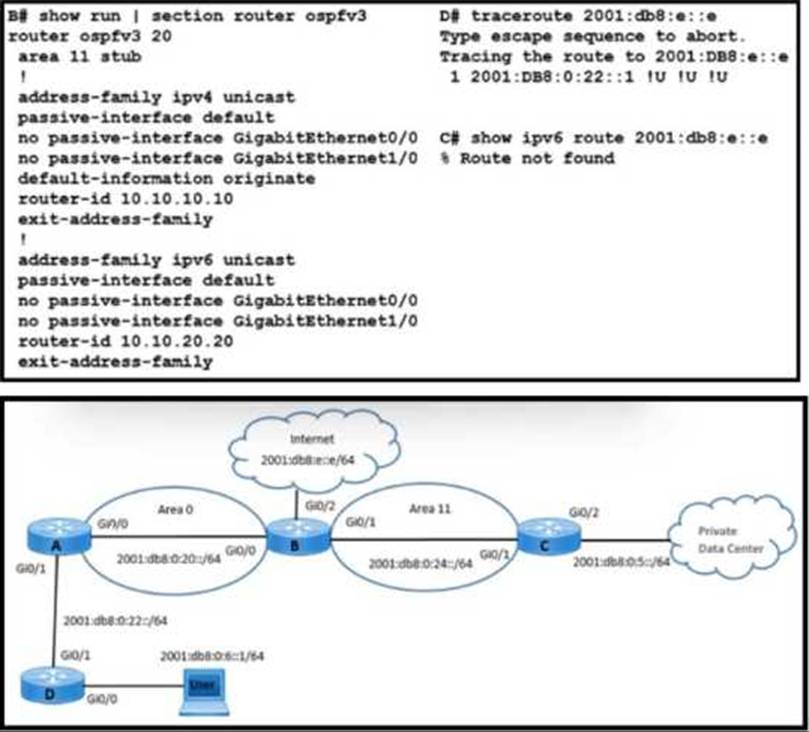
An enterprise user reports an access issue with IPv6 content on the Internet. The user can access IPv4 content that is at the data center.
Which action resolves the issue with IPv6 content?
- A . Change Area 11 to Area 0 between routers B and C.
- B . Add a static route for 2001: db8:0:6::1/64 on router B RIB.
- C . Advertise the 2001:db8: e::e/64 route on the router D OSPF process.
- D . Enable default information to originate in IPv6 AF on router B.
A switch has been configured to provide DHCP relay on VLAN 100 to a server with an IP address of 10.1.1.1. The DHCP server is sending syslog reports of multiple TFTP requests that also originate from the switch. As a result, the server CPU exceeded a configured threshold.
Which action does the network administrator recommend to bring the server CPU threshold down?
- A . Configure the switch with an access list on VLAN100 to deny TFTP.
- B . Configure the switch with a VACL on VLAN100 to deny TFTP.
- C . Configure the switch with ip forward-protocol udp 67 globally.
- D . Configure the switch with no ip forward-protocol udp 69 on VLAN100.
Refer to the exhibit.

A network engineer is provisioning end-to-end traffic service for two different enterprise networks with these requirements
✑ The OSPF process must differ between customers on HQ and Branch office routers, and adjacencies should come up instantly.
✑ The enterprise networks are connected with overlapping networks between HO and a branch office
Which configuration meets the requirements for a customer site?
A)

B)

C)

D)

- A . Option A
- B . Option B
- C . Option C
- D . Option D
Clients on ALS2 receive IPv4 and IPv6 addresses but clients on ALS1 receive only IPv4 addresses and not IPv6 addresses.
Which action on DSW1 allows clients on ALS1 to receive IPv6 addresses?
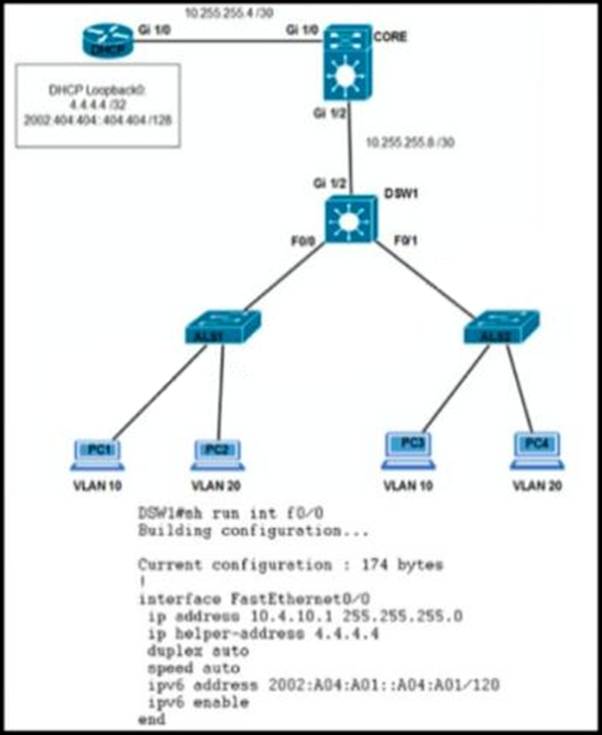
- A . Configure DSW1(config-if)#ipv6 helper address 2002:404:404::404:404
- B . Configure DSW1(dhcp-config)#default-router 2002:A04:A01::A04:A01
- C . Configure DSW1(config)#ipv6 route 2002:404:404:404:404/128 FastEthernet1/0
- D . Configure DSW1(config-if)#ipv6 dhcp relay destination 2002:404:404::404:404 GigabitEthernet1/2
B
Explanation:
https://community.cisco.com/t5/networking-documents/stateful-dhcpv6-relay-configuration-example/ta-p/3149338
Refer to the exhibit.
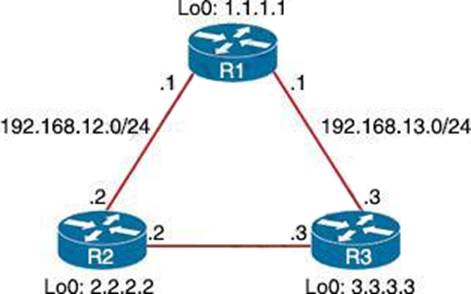
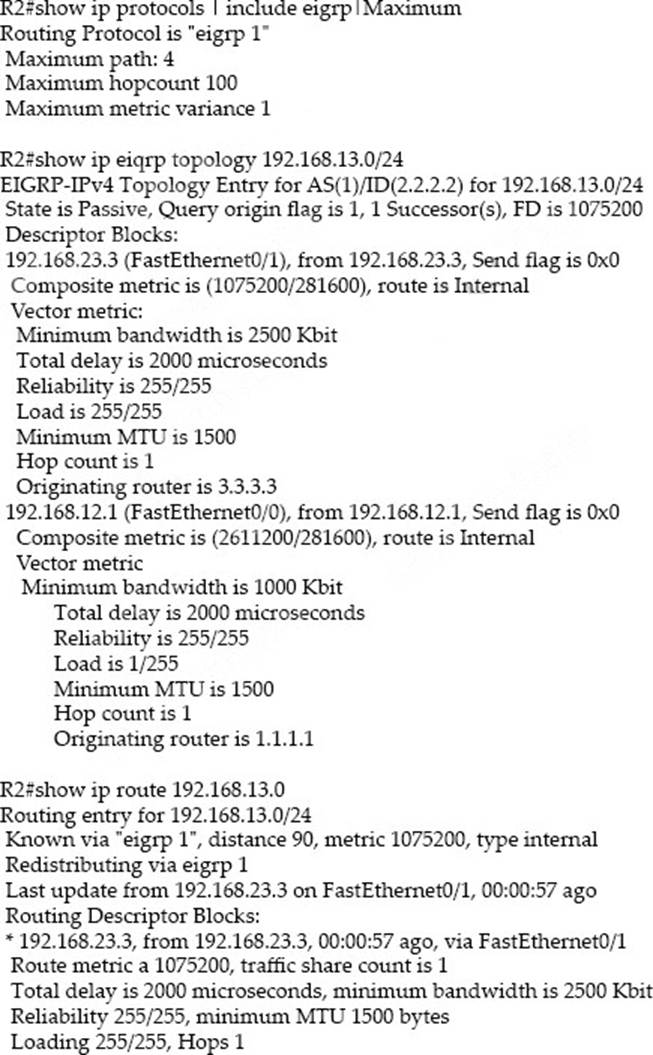
R2 has two paths to reach 192.168.13.0/24. but traffic is sent only through R3.
Which action allows traffic to use both paths?
- A . Configure the bandwidth 2000 command under interface FastEthernet0/0 on R2.
- B . Configure the variance 4 command under the EIGRP process on R2.
- C . Configure the delay 1 command under interface FastEthernet0/0 on R2.
- D . Configure the variance 2 command under the EIGRP process on R2
B
Explanation:
From the output of the “show ip eigrp topology …” command, we notice network 192.168.13.0/24 was learned via two routes:
+ From 192.168.23.3 (R3) with FD = 1075200 and AD = 281600
+ From 192.168.12.1 (R1) with FD = 2611200 and AD = 281600
From the output of the “show ip route …” command, we learned that the best (and chosen) path is via 192.168.23.3 (R3).
To use both paths (called unequal cost load balancing) with EIGRP, the second path via R1 must satisfy the feasibility condition. The feasibility condition states that, the Advertised Distance (AD) of a route must be lower than the feasible distance of the current successor route.
In this case, the second path satisfies the feasible condition as its AD (281600) is smaller than the FD (1075200) of the best path. Therefore we can configure loadbalancing with “variance” command.
In other words, EIGRP will install all paths with metric < variance * best_metric into the local routing table, provided that it meets the feasibility condition to preventrouting loop. Therefore we can calculate the variance > metric / best_metric = 2611200 / 1075200 =2.4.
So with a variance greater than 2 (and must be an integer), we can load balance traffic to network 192.168.13.0/24.
What are the two prerequisites to enable BFD on Cisco routers? (Choose two)
- A . A supported IP routing protocol must be configured on the participating routers.
- B . OSPF Demand Circuit must run BFD on all participating routers.
- C . ICMP must be allowed on all participating routers.
- D . UDP port 1985 must be allowed on all participating routers.
- E . Cisco Express Forwarding and IP Routing must be enabled on all participating routers.
Refer to the exhibit.
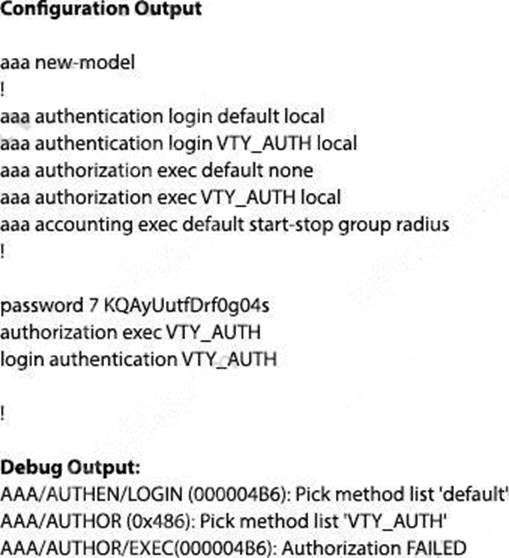
Which action resolves the failed authentication attempt to the router?
- A . Configure aaa authorization login command on line vty 0 4
- B . Configure aaa authorization login command on line console 0
- C . Configure aaa authorization console global command
- D . Configure aaa authorization console command on line vty 0 4
C
Explanation:
In the debug output, we see that the Authorization (not Authentication) failed so we need to correct the authorization. In order to enable authorization, we must use the global command “aaa authorization console” first.
Reference: https://www.cisco.com/c/en/us/td/docs/ios-xml/ios/security/a1/sec-a1-cr-book/sec-cr-a1.html
What are two functions of LDP? (Choose two.)
- A . It is defined in RFC 3038 and 3039.
- B . It requires MPLS Traffic Engineering.
- C . It advertises labels per Forwarding Equivalence Class.
- D . It must use Resource Reservation Protocol.
- E . It uses Forwarding Equivalence Class
C,E
Explanation:
https://www.cisco.com/c/en/us/td/docs/switches/datacenter/sw/5_x/nx-os/mpls/configuration/guide/mpls_cg/mp_mpls_overview.pdf
Refer to the exhibit.
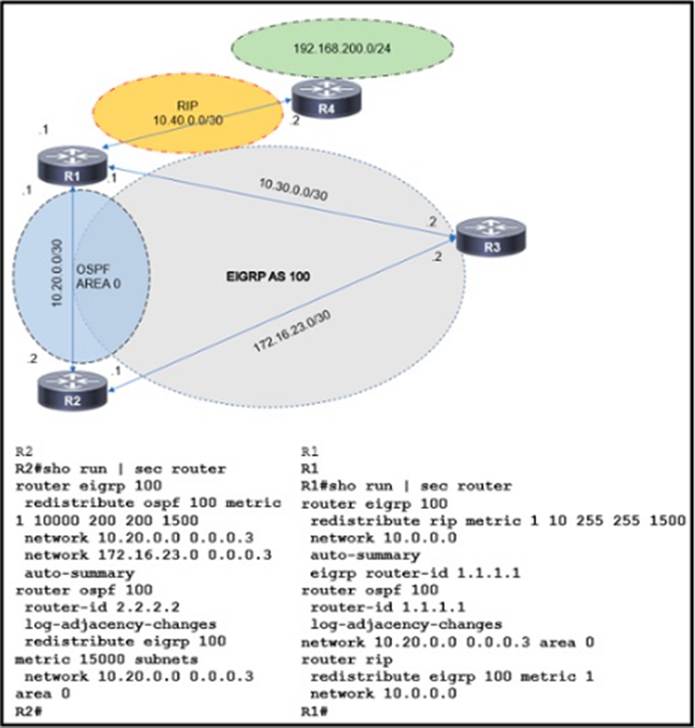
The route to 192 168 200 0 is flapping between R1 and R2.
Which set of configuration changes resolves the flapping route?
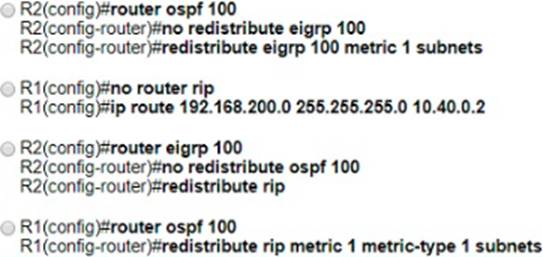
- A . Option A
- B . Option B
- C . Option C
- D . Option D
What is the output of the following command:
show ip vrf
- A . Show’s default RD values
- B . Displays IP routing table information associated with a VRF
- C . Show’s routing protocol information associated with a VRF.
- D . Displays the ARP table (static and dynamic entries) in the specified VRF
